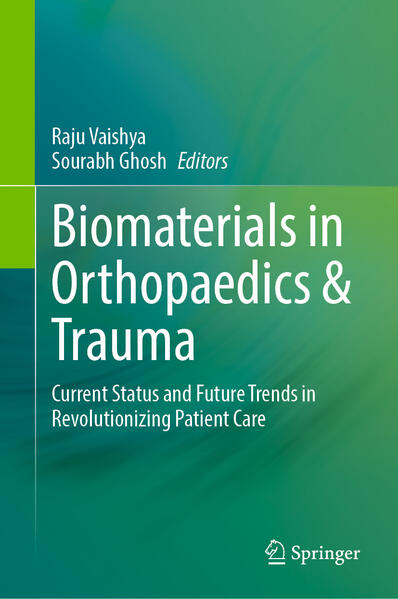
Zustellung: Fr, 23.05. - Fr, 30.05.
Versand in 5 Wochen
VersandkostenfreiBestellen & in Filiale abholen:
The landscape of orthopaedics and trauma is rapidly evolving, driven by groundbreaking advancements in biomaterials. This book offers an in-depth exploration of the current state-of-the-art, highlighting the latest innovations and their clinical applications.
The intersection of materials science and medicine has given rise to a revolutionary field: biomaterials. These engineered substances, designed to interact with biological systems, have become indispensable in orthopaedics and trauma surgery. From repairing broken bones to replacing worn-out joints, biomaterials have significantly advanced patient care and quality of life.
In recent years, the focus has shifted towards bioactive and biodegradable materials. Bioactive materials, such as calcium phosphate ceramics, actively interact with bone tissue, promoting bone growth and integration. This characteristic is particularly valuable in bone grafts and tissue engineering applications. On the other hand, biodegradable materials, like polylactic acid (PLA) and polyglycolic acid (PGA), offer the advantage of being gradually absorbed by the body as the surrounding tissue regenerates. These materials are employed in various forms, including screws, plates, and bone scaffolds.
This book offers a holistic view of biomaterials in orthopaedics and trauma by presenting an understanding of the fundamental properties of biomaterials and exploring their role in tissue regeneration and implant design. This comprehensive resource also delves into the future, examining emerging trends and technologies that are revolutionizing patient care and paving the way for new treatment modalities. This book is an essential guide to the exciting world of biomaterials for orthopaedic surgeons, trauma surgeons and biomedical researchers.
Inhaltsverzeichnis
Part I. Biomaterials and Their Applications. - Chapter 1. Evolution of Biomaterials in Orthopaedics (Abhishek Vaish). - Chapter 2. Biophysics of Biomaterials (Harsh Singh). - Chapter 3. Advanced Materials in Orthopedics (Bibek Banskota). - Chapter 4. Advancements in Biomaterials for Enhanced Management of Fragility Fractures (Ahmed Khalifa). - Chapter 5. Biomaterials for Non-Union of Fractures Management (Madhan Jeyaraman). - Chapter 6. Enhancing Orthopaedic and Traumatology Implant Efficacy: Innovations in Surface Modification Techniques (Ahmed Khalifa). - Chapter 7. Biomimetic biomaterials for orthopaedic application (Bhaskar Borgahin). - Chapter 8. Advancements in Biomimetic Orthopedic Implants (Vinay Samant). - Chapter 9. Advancements in Biomaterials for Cartilage Tissue Engineering (Madhan Jeyaraman). - Chapter 10. Decellularized Extracellular Matrices: A Future for Musculoskeletal Regeneration(Santosh Jeevanavar). - Chapter 11. Antimicrobial implant coatings (Khalid Al Homayani). - Part II. 3D Printing and Additive Manufacturing. - Chapter 12. Principle, Evolution and Impact of 3D Printing Technology (Sushant Srivastava). - Chapter 13. Impact of 3D Printed Implants and Patient-Specific Instrumentation (Amit Yadav). - Chapter 14. Role of Additive Manufacturing in Patient-Specific Implants and Tissue Engineering (Mohd Javaid). - Chapter 15. Advances, Challenges, and Future Perspectives in Patient-Specific Implants and Surgical Guides (Rohan Khoturkar). - Chapter 16. Customised 3D Printed Implants and Instruments in Orthopaedics (Vikas Jain). - Chapter 17. Evolution and Impact of Customized Implants with Intricate Designs (Vincenzo Filardi). - Chapter 18. Tailored Silk-Fibroin Biomaterials for Accelerated Cartilage Regeneration using 3D Bioprinting (Chandrashish Roy). - Part III. Stem Cells and Tissue Engineering. - Chapter 19. Stem cells and scaffolds for bone and cartilage repair (Prasoon Kumar). Chapter 20. Regenerative medicine in tendon pathologies (Rahul Jaiswal). - Chapter 21. The Intersection of Biomaterials and Stem Cells in Tissue Repair (Santosh Jeevanavar). - Part IV. Sensor Technology and Smart Implants. - Chapter 22. Understanding the Basics of Sensor Technology (Senthivalen Rajagopalan). - Chapter 23. Integration of Sensor-Based Technology and SMART Implants in Joint Replacement Surgery (KP Iyengar). - Chapter 24. Impact of Sensor Technology on Patient Outcomes (Chaitanya Dev Pannu). - Part V. Nanotechnology. - Chapter 25. The Role of Nanotechnology from Laboratory Research to Clinical Applications (Nitesh Gahlot). - Chapter 26. Current research, challenges and future directions in Nanotechnology (S Saseendar).
Produktdetails
Erscheinungsdatum
28. Mai 2025
Sprache
englisch
Seitenanzahl
416
Herausgegeben von
Raju Vaishya, Sourabh Ghosh
Verlag/Hersteller
Produktart
gebunden
Abbildungen
VI, 416 p. 77 illus., 71 illus. in color.
ISBN
9789819630165
Entdecken Sie mehr
Bewertungen
0 Bewertungen
Es wurden noch keine Bewertungen abgegeben. Schreiben Sie die erste Bewertung zu "Biomaterials in Orthopaedics & Trauma" und helfen Sie damit anderen bei der Kaufentscheidung.










